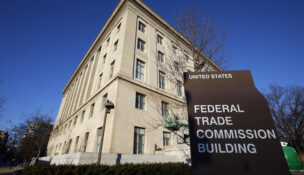Governmental immunity law weakened
By: dmc-admin//July 12, 2010//
Yet another Wisconsin Supreme Court justice has joined the chorus calling for reexamination of how the court interprets the governmental immunity statute.
On July 2, in the case of Pries v. McMillon, Justice Michael J. Gableman wrote a dissenting opinion, concluding, “our case law is, troublingly, untethered from the governing statute, Wis. Stat. sec. 893.80(4).”
Justices David Prosser and N. Patrick Crooks have previously complained, or joined opinions complaining, that the case law is unsupported by the text of the statute.
In the latest case, Michael Pries, an inmate at the Milwaukee County House of Corrections, was in a group of 12 inmates brought to the State Fair Park to dismantle horse stalls.
Raymond McMillon, an employee with the State Fair, supervised the inmates.
A state fair document containing instructions for removing stalls provided, “Always have someone holding up the piece that you are taking down.”
Nevertheless, while the crew struggled to dislodge a stall piece that was stuck to another, McMillon jumped up on and straddled a stall next to it, and started jerking it up and down. Unchained stall pieces started falling in a domino effect on the inmates, injuring Pries.
Pries sued McMillon for negligence, and the defendants moved for summary judgment on the grounds of governmental immunity.
The circuit court denied the motion, concluding that the instructions created a ministerial duty that McMillon breached.
The Court of Appeals affirmed, in a published opinion, but on the ground that the known danger exception to governmental immunity applied. Pries v. McMillon, 2008 WI App 167, 314 Wis.2d 706, 760 N.W.2d 174.
The Supreme Court granted review and affirmed, but on the ground cited by the circuit court.
In the majority opinion by Justice Crooks, the court concluded that the take-down instructions are a source of law that created a ministerial duty. Because it decided the case on this basis, it did not consider whether the known danger exception would also apply.
To create such a duty, the instructions must specifically provide the time, mode and occasion for performing an act “with such certainty that nothing remains for judgment or discretion.”
The court concluded that the instructions, which included the word, “always,” created such a duty.
Noting that the pieces weighed approximately 200 pounds, and require four people to lift, some of whom will not have experience with the equipment, the court concluded that a nondiscretionary set of procedures is a necessity.
The court wrote, “As the circuit court noted, ‘[D]isassembling horse stalls is a process that can, and should, be controlled with set guidelines so as to preserve equipment and prevent injury, workers are not given discretion as to performing disassembly.’ Those circumstances support the conclusion that the instruction in section 6(a) is not discretionary but is purely ministerial.”
Chief Justice Abrahamson wrote a concurring opinion, agreeing with the Court of Appeals that the known danger exception applies — “the nature of the danger is compelling and known to the officer and is of such force that the public officer has no discretion not to act.”
Abrahamson wrote, “Disassembly here is an ‘accident waiting to happen’ and gives rise to an absolute duty to take steps to prevent the steel horse stall pieces from falling. McMillon knew the unchained steel stall pieces were dangerous; he was in a position as supervisor to do something about the danger; and he failed to do anything about it — worse, he jumped onto the stalls. In my view, he thereby breached a duty that was ‘absolute, certain, and imperative’ following the analysis of the known danger cases.”
Justice Ann Walsh Bradley dissented, in an opinion joined by Justices Gableman and Patience Drake Roggensack.
Bradley wrote, “Today’s decision expands the liability of public officers far beyond the confines established by more than a half-century of precedent. The result of this expansion could expose not only the Wisconsin State Fair Park to liability, but also villages, towns, cities, school boards, and other state and local government treasuries at a time when these entities can least afford it.”
Bradley criticized the majority opinion for looking beyond the text of the written procedures, and relying on the opinions of co-workers regarding how to safely perform the task.
The dissent opined, “By untethering its analysis from the language of the written procedure, the majority departs from our established approach. Although courts have reviewed employee testimony to confirm that an employee is responsible for complying with the text of a specific statute, regulation, or procedure, they have not used testimony to change the meaning of that text, as the majority does here.”
Despite joining Justice Bradley’s dissent, with respect to the applicable case law governing governmental immunity, Justice Gableman wrote separately, to criticize that case law.
Noting that the text of the statute only provides immunity for governmental bodies for the intentional torts of their officers and employees, and “for acts done in the exercise of legislative, quasi-legislative, judicial or quasi-judicial functions,” Gableman concluded that the court’s common law exceptions are contrary to the letter and the spirit of the statute.
Gableman noted that, seven years ago, Justice Prosser called for reexamination of the law, in Scott v. Savers Prop. & Cas. Ins. Co., 2003 WI 60, 262 Wis.2d 127, 663 N.W.2d 715 (Prosser, J., dissenting).
Then-justice Bablitch also wrote separately in Scott, in an opinion joined by Justice Crooks, stating “Although the majority’s result is consistent with past cases, it is also an unjust result. This court should revisit these past cases for the reasons so well stated in the dissent of Justice Prosser. A doctrine of governmental immunity that has caused such injustice and inequity, in this case and others, cannot, and I predict, will not, stand much longer.”
Last term, in Umansky v. Fox, 2009 WI 82, 319 Wis.2d 622, 769 N.W.2d 1, Prosser renewed that call, in a concurrence joined by Crooks.
Robert L. Jaskulski, who wrote an amicus curiae brief for the Wisconsin Association of Justice in the Pries case, asking the court to reexamine the law, said the problem is that the court seems reluctant to address the issue head-on, when the fact pattern falls within a recognized exception.
“The court is loosening the reins as to what fits within the exceptions, but is showing reluctance to take on the central issue, and go back to the statute as written — liability is the rule, and immunity the exception.”
Jaskulski said a test case may be needed, in which it is clear that mere negligence is involved and neither the ministerial duty nor the known danger exceptions apply.
David Ziemer can be reached at [email protected].
Legal News
- Iranian nationals charged cyber campaign targeting U.S. Companies
- Wisconsin court issues arrest warrant ‘in error’ for Minocqua Brewing owner
- Chicago man sentenced to prison after being caught with ‘Trump Gun’
- FTC bans non-competes
- Gov. Evers seeks applicants for Dane County Circuit Court
- Milwaukee man charged in dismemberment death pleads not guilty
- Democratic-led states lead ban on the book ban
- UW Madison Professor: America’s child care crisis is holding back moms without college degrees
- History made in Trump New York trial opening statements
- Prosecutor won’t bring charges against Wisconsin lawmaker over fundraising scheme
- Republican Wisconsin Senate candidate says he doesn’t oppose elderly people voting
- Vice President Harris to reveal final rules mandating minimum standards for nursing home staffing
WLJ People
- Power 30 Personal Injury Attorneys – Russell Nicolet
- Power 30 Personal Injury Attorneys – Benjamin Nicolet
- Power 30 Personal Injury Attorneys – Dustin T. Woehl
- Power 30 Personal Injury Attorneys – Katherine Metzger
- Power 30 Personal Injury Attorneys – Joseph Ryan
- Power 30 Personal Injury Attorneys – James M. Ryan
- Power 30 Personal Injury Attorneys – Dana Wachs
- Power 30 Personal Injury Attorneys – Mark L. Thomsen
- Power 30 Personal Injury Attorneys – Matthew Lein
- Power 30 Personal Injury Attorneys – Jeffrey A. Pitman
- Power 30 Personal Injury Attorneys – William Pemberton
- Power 30 Personal Injury Attorneys – Howard S. Sicula











